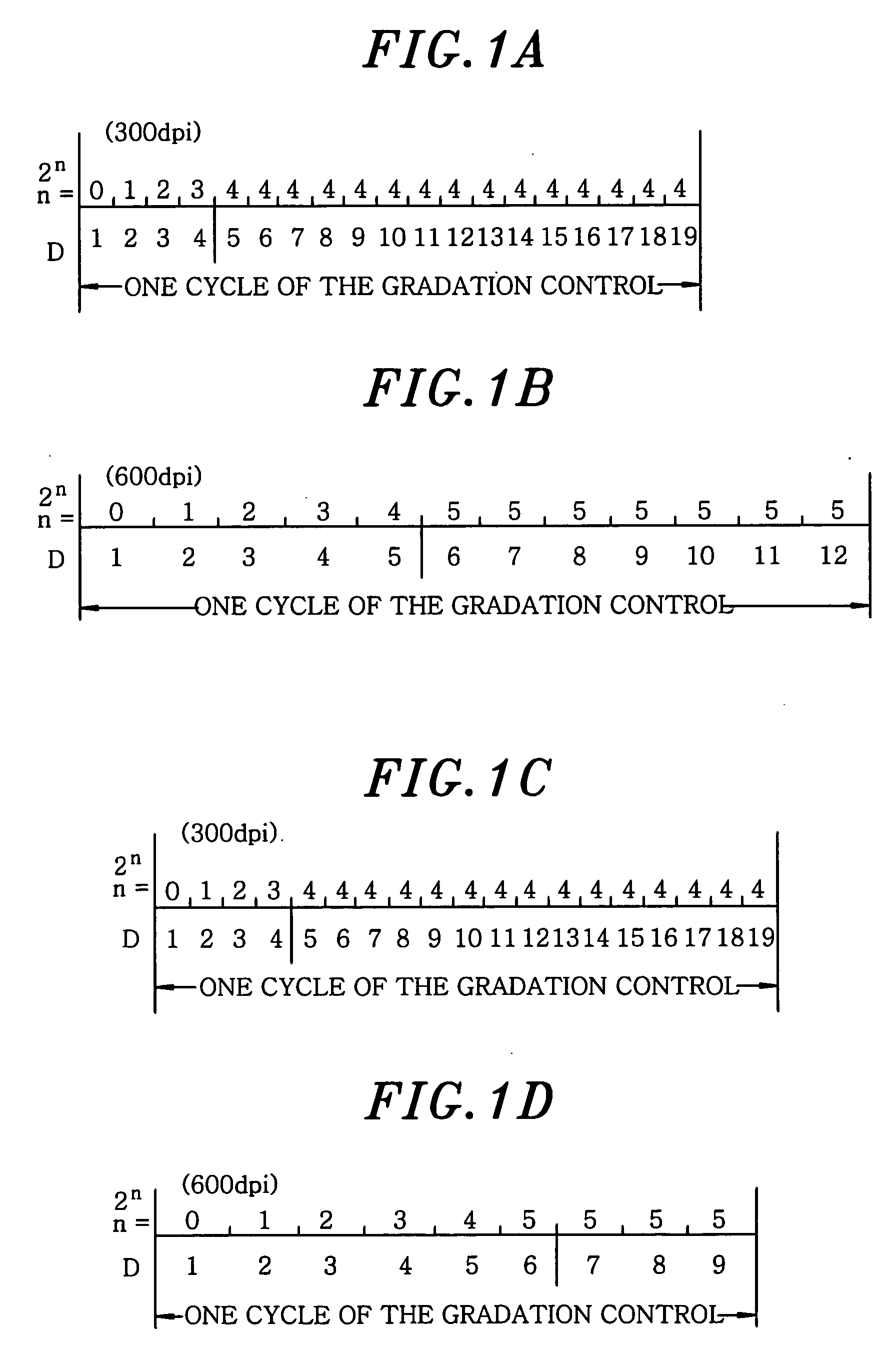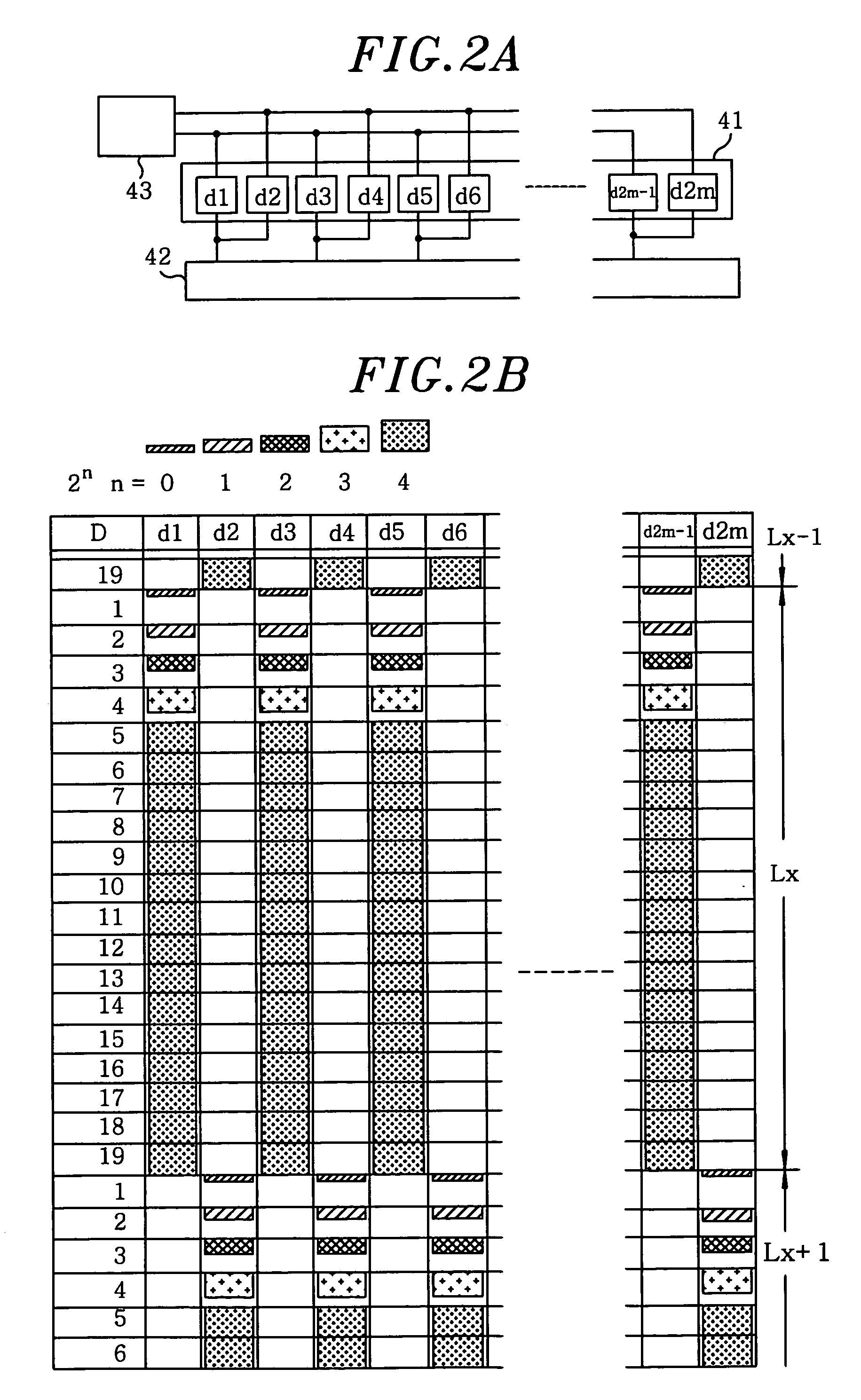Print head driving method and image formation apparatus using the same
a driving method and printing head technology, applied in the direction of instruments, visual presentations, computing, etc., can solve the problems of increasing the time required for the transmission of image data, increasing the printing time, and reducing resolution
- Summary
- Abstract
- Description
- Claims
- Application Information
AI Technical Summary
Benefits of technology
Problems solved by technology
Method used
Image
Examples
first preferred embodiment
[0058]FIGS. 1A to 1D describe a gradation control method in accordance with a first preferred embodiment of the present invention.
[0059] The gradation control of array light sources shown therein is based on 8-bit image data. FIGS. 1A and 1C describe a case of using an array light source having a resolution of 300 dpi, whereas FIGS. 1B and 1D depict a case of using an array light source having a resolution of 600 dpi. Further, driving frequencies of driving circuits of the array light sources are same in both cases, and the time periods designated as “one cycle of the gradation control” in FIGS. 1A to 1D only show data transmission times, and the non-emission times are omitted therefrom for simplicity.
[0060] The array light source having the resolution of 300 dpi is used for generating, e.g., green or blue light, and fluorescent luminous tubes are employed therein. The array light source having the resolution of 600 dpi is used for generating red light, and LEDs are employed there...
second preferred embodiment
[0069]FIGS. 2A and 2B describe a gradation control method in accordance with a second preferred embodiment of the present invention, in which the pulse accumulation method and the pulse weight-application method are combined, and an interlace method for alternately driving odd-numbered light emitting elements and even-numbered light emitting elements alternately once for each cycle of gradation control is applied thereto.
[0070] Moreover, though a print head in this embodiment employs both an array light source having a resolution of 300 dpi and an array light source having a resolution of 600 dpi, the interlace method is only applied to the array light source having the resolution of 600 dpi. FIGS. 2A and 2B only illustrate the case of using the 600 dpi array light source.
[0071]FIG. 2A shows a driving circuit of an array light source 41 in which light emitting elements d1 to d2m formed of LEDs are installed in a pattern of an array. The array light source 41 has a resolution of 60...
third preferred embodiment
[0078]FIGS. 3A to 3E illustrate a gradation control method in accordance with a third preferred embodiment of the present invention. The method combines a driving method for alternating odd-numbered light emitting elements and even-numbered light emitting elements for each bit as well as combining a pulse accumulation method and a pulse weight-application method.
[0079] Further, although a print head in this embodiment employs both array light sources having a resolution of 300 dpi and an array light source having a resolution of 600 dpi, the method for alternating the light emitting elements once for each bit is applied only to the array light source of 600 dpi. Further, FIGS. 3A to 3E illustrate the gradation control of the array light source of 600 dpi, and only four light emitting elements d1 to d4 among light emitting elements d1 to d2m are shown therein.
[0080] Hereinafter, FIG. 3A will be explained first.
[0081] During a cycle of the gradation control Lx, image data is transm...
PUM
 Login to View More
Login to View More Abstract
Description
Claims
Application Information
 Login to View More
Login to View More - R&D
- Intellectual Property
- Life Sciences
- Materials
- Tech Scout
- Unparalleled Data Quality
- Higher Quality Content
- 60% Fewer Hallucinations
Browse by: Latest US Patents, China's latest patents, Technical Efficacy Thesaurus, Application Domain, Technology Topic, Popular Technical Reports.
© 2025 PatSnap. All rights reserved.Legal|Privacy policy|Modern Slavery Act Transparency Statement|Sitemap|About US| Contact US: help@patsnap.com



